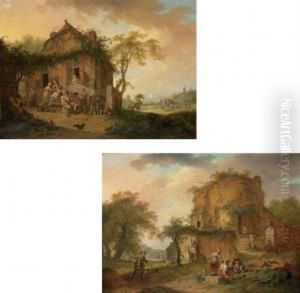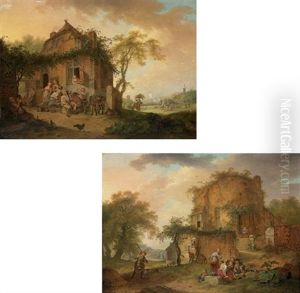Heinrich Meyer Paintings
Johann Heinrich Meyer, often known simply as Heinrich Meyer, was a notable Swiss painter, draftsman, and art writer. Meyer was born on March 16, 1760, in Stäfa, near Zurich, Switzerland. His initial exposure to art came through his father, who was a pastor and amateur painter. Meyer's artistic inclination was evident from a young age, and he received his first formal art education at the age of sixteen in Zurich.
In 1784, Meyer left Switzerland to further his studies in Italy, which was a common practice among European artists seeking to advance their skills and knowledge. He spent a significant amount of time in Rome, which was then the center of the neoclassical art movement. It was in Rome that he met Johann Wolfgang von Goethe, the renowned German writer and statesman, who would become a lifelong friend and collaborator. Meyer's association with Goethe had a profound influence on his career and thinking.
Meyer became an important figure in the German art world, particularly through his involvement with the Weimar art school, which was associated with Goethe. His work as an artist was strongly influenced by neoclassicism, and he produced historical and mythological paintings, portraits, and landscapes. Meyer's role as an art theorist and historian was also significant. He collaborated with Goethe on the 'Propyläen', a journal that aimed to educate and guide artists and the public in the principles of neoclassical aesthetics.
Meyer was not only a practitioner but also an influential teacher and administrator. He played a key role in the development of the Weimar Princely Free Drawing School, where he taught and influenced a generation of artists. He was a proponent of the idea that art should serve moral and educational purposes, and he emphasized the importance of studying the works of the Old Masters as well as nature.
Throughout his life, Meyer remained an ardent supporter of neoclassical ideals, even as the tides of artistic fashion began to turn towards Romanticism. He maintained his connection with Goethe until the writer's death in 1832. Heinrich Meyer's own life came to an end later that same year on October 14, in Weimar, where he had spent much of his professional life. Although he may not be as widely remembered as some of his contemporaries, his contributions to the theory and practice of art during his time were considerable, and his influence was felt by many who studied and worked under his guidance.

